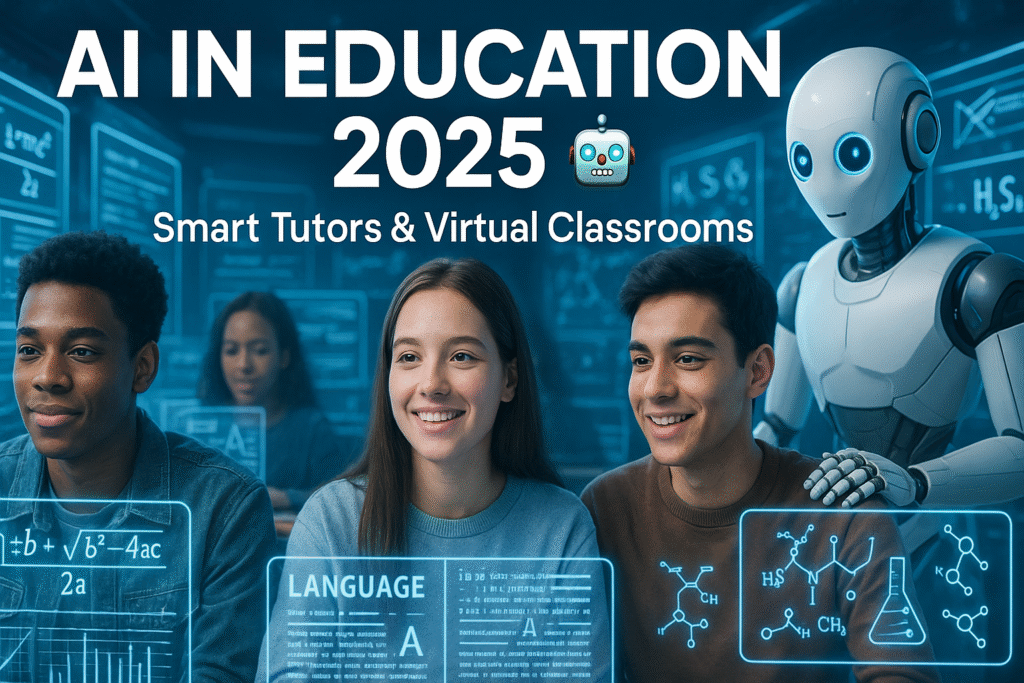🌍 Introduction: The Classroom Revolution
Education in 2025 looks nothing like it did a decade ago. The chalkboard has evolved into a smartboard, homework has become interactive, and teachers have digital assistants powered by Artificial Intelligence (AI).
From AI-driven tutoring apps that personalize learning to virtual classrooms connecting students across continents, technology isn’t just supporting education anymore — it’s transforming it.
AI has redefined how students learn, how teachers teach, and how schools operate. Let’s explore how AI-powered education is shaping the future of learning across the globe.
🤖 What Is AI in Education?
Artificial Intelligence (AI) in education refers to the use of machine learning, natural language processing, and data analytics to personalize, automate, and enhance the learning experience.
In 2025, AI tools analyze a student’s strengths, weaknesses, and learning styles to create a custom roadmap for academic success. They act as tutors, graders, and even classroom companions — improving engagement, accessibility, and efficiency.
📚 The Rise of Smart Tutors
1. Personalized Learning Paths
Traditional classrooms follow one-size-fits-all teaching methods. AI tutors change that by creating adaptive learning journeys for each student.
Apps like Socratic (by Google), Khanmigo (Khan Academy’s AI tool), and ChatGPT-powered study assistants evaluate performance in real time and adjust the difficulty level accordingly.
For example:
If a student struggles with algebra, the AI tutor simplifies explanations, adds interactive visuals, and provides micro-quizzes until mastery is achieved.
2. 24/7 Academic Assistance
Unlike human tutors, AI tutors are always available. Students can ask questions at any hour and receive instant, step-by-step explanations — in their preferred language or style.
This has been a game-changer for students in remote areas or different time zones, breaking the limits of geography and access.
3. Emotionally Intelligent Learning
In 2025, advanced AI models use emotion recognition through cameras and voice tone analysis to gauge a learner’s mood or stress level.
If a student seems disengaged, the AI might change the teaching style — for example, switching from a lecture to a quiz or showing an animated explainer video.
🧠 Virtual Classrooms: The New Global Campus
1. Immersive, Interactive Lessons
Virtual classrooms now use AR (Augmented Reality) and VR (Virtual Reality) to bring subjects to life.
Imagine walking through ancient Rome during a history lesson or exploring the human body in 3D during biology class.
Platforms like Google Classroom VR, Meta LearnVerse, and Microsoft Mesh for Education have turned learning into an experience rather than a chore.
2. AI-Driven Collaboration
AI moderates discussions, groups students based on strengths, and even translates in real time for multilingual classrooms.
A student in India can collaborate seamlessly with a peer in France — no language barrier, no time constraint.
3. Smart Attendance & Participation Tracking
Facial recognition tools powered by AI automate attendance and assess participation. Educators receive weekly insights like:
- “Student X asked 20% fewer questions this week.”
- “Student Y excels in visual learning but struggles with text-heavy materials.”
These insights help teachers focus their attention where it’s needed most.
💬 AI as a Teacher’s Assistant
1. Automated Grading and Feedback
AI now grades essays, quizzes, and even creative assignments. Platforms like Gradescope, Turnitin AI, and Edmodo GPT analyze grammar, logic, and argument quality to give instant, detailed feedback.
Teachers save up to 10 hours a week, freeing them to focus on mentorship and creative teaching.
2. Curriculum Design and Analytics
AI tools study academic performance data to suggest curriculum improvements.
For instance, if multiple students struggle with a particular math concept, the system recommends restructured lessons or supplemental materials.
3. Identifying Learning Gaps Early
AI predicts which students might fall behind based on behavioral patterns — missed assignments, test anxiety, or reduced participation — allowing teachers to intervene early with personalized support.
🌐 Global Impact: Democratizing Education
AI is making quality education accessible to millions worldwide.
1. Bridging the Rural-Urban Divide
Virtual classrooms powered by AI enable rural students to access the same resources as those in metropolitan cities.
Affordable learning apps like BYJU’S AI, Coursera AI Labs, and Duolingo Max bring world-class education to handheld devices.
2. Breaking Language Barriers
AI translation tools allow students to learn in their native languages, removing one of the biggest obstacles in global education.
A student in Japan can now take a Harvard course in Japanese, while a learner in Kenya can access MIT materials in Swahili.
3. Inclusivity for Students with Disabilities
AI-driven accessibility tools like speech-to-text, text-to-speech, and real-time captioning empower students with hearing or visual impairments.
AI even adjusts text size, contrast, or reading speed based on the user’s needs — creating truly inclusive classrooms.
💼 AI and Career Readiness
Education powered by AI isn’t just about grades — it’s about skills for the future.
1. AI Career Counselors
Virtual career assistants like LinkedIn Career Coach AI or Coursera PathFinder analyze students’ skills, interests, and global job trends to recommend ideal career paths.
2. Skill-Based Learning Platforms
AI curates personalized micro-courses that align with real-world industries — from coding and data analytics to creative design and entrepreneurship.
3. Internship and Job Matching
AI systems connect students with companies that fit their profiles, making the transition from education to employment seamless.
🧩 Challenges and Ethical Concerns
1. Data Privacy & Security
AI systems collect vast amounts of personal data — from test scores to emotional responses. Without strong regulations, this could lead to data misuse or surveillance risks.
2. Overreliance on AI
While AI enhances learning, it can’t replace the empathy and human connection that teachers provide. Overdependence might reduce creativity and emotional intelligence in students.
3. Digital Divide
Not every region has equal access to technology. Without equitable infrastructure, AI in education could widen the gap between rich and poor nations.
4. Bias in Algorithms
AI learns from data — and if that data carries biases, it can result in unequal learning experiences. Ensuring fairness and transparency in algorithms is a top priority for 2025 and beyond.
📈 Case Studies: How AI Is Changing Real Classrooms
🏫 1. Finland’s Smart Schools Initiative
Finland’s public schools use AI analytics to create individualized study plans. Teachers receive daily insights into each student’s emotional well-being and academic performance.
🇮🇳 2. India’s EdTech Boom
Platforms like BYJU’S, Unacademy, and Vedantu have adopted AI tutoring systems that recommend lessons based on student behavior. Millions of rural learners now access interactive lessons through low-data mobile apps.
🇺🇸 3. United States – AI in Universities
MIT, Stanford, and Harvard have launched AI Teaching Assistants that handle queries, manage grading, and even lead discussions.
MIT’s “AI TA” answered 10,000 student questions in one semester with 92% accuracy — saving professors countless hours.
🧮 Numbers That Speak: The AI Education Boom
| Metric | 2020 | 2025 (Projected) |
|---|---|---|
| AI in Education Market Size | $1.5 Billion | $25 Billion |
| Global Students Using AI Tutors | 20 Million | 300 Million |
| Schools Using AI-Based Learning Tools | 5% | 45% |
| AI Contribution to EdTech Startups | $0.8 Billion | $10.4 Billion |
Source: UNESCO, Global EdTech Report 2025
The numbers confirm one thing: AI is no longer the future of education — it’s the present.
🧬 The Human + AI Hybrid Model
Experts agree that the best approach is a hybrid model — combining the efficiency of AI with the empathy of human educators.
In this model:
- AI handles repetition — quizzes, grading, progress tracking.
- Teachers handle inspiration — motivation, emotional support, creativity.
This partnership ensures that technology enhances humanity rather than replaces it.
🚀 What’s Next? The Future of AI in Education
1. AI-Powered Creativity Labs
Schools will soon have AI that helps students write poetry, compose music, or simulate science experiments in 3D.
2. Real-Time Curriculum Updates
AI will adapt textbooks dynamically based on new research or student performance data.
3. Global Learning Ecosystems
AI will connect classrooms worldwide, making learning borderless and culturally inclusive.
4. AI in Exams
Smart testing will assess not only what students know but how they think — shifting focus from rote memorization to creative problem-solving.
🏁 Conclusion: A Smarter Tomorrow
In 2025, AI in education isn’t just about smarter tools — it’s about smarter minds.
From kindergarten to university, every aspect of learning is being reshaped by algorithms that understand, adapt, and empower.
But even as technology evolves, one truth remains timeless:
“The best education combines intelligence with empathy.”
AI is here to enhance learning, not replace human connection.
And when teachers, students, and AI work together, the result isn’t just better grades — it’s a generation of thinkers ready to build the future.

